

Wealth inequality has widened along racial, ethnic lines since end of Great Recession
The Great Recession, fueled by the crises in the housing and financial markets, was universally hard on the net worth of American families. But even as the economic recovery has begun to mend asset prices, not all households have benefited alike, and wealth inequality has widened along racial and ethnic lines.
The wealth of white households was 13 times the median wealth of black households in 2013, compared with eight times the wealth in 2010, according to a new Pew Research Center analysis of data from the Federal Reserve’s Survey of Consumer Finances. Likewise, the wealth of white households is now more than 10 times the wealth of Hispanic households, compared with nine times the wealth in 2010…
Link to report
Mexican professionals bringing ambition, startups to North Texas
Dallas Morning News
A cocktail mixer sponsored by the Association of Mexican Entrepreneurs …. “Americans respect power, and that’s what we’re striving for, economic …
Link to article
Slow and Steady Progress for Mexican American Professionals: The results of the American surveys for the years 2010-2012 show positive results
By Humberto Gutierrez
Edited by Kristen House
College enrollment showed an increase of 1.4 percent from 2010 to 2012—a positive sign for Mexican Americans wanting to achieve higher academic and professional goals. Here is the data.

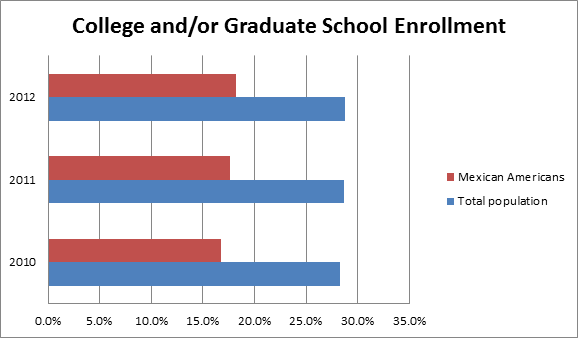
Educational attainment shows no change to the terrible numbers of 2.6 percent for the years 2010 and 2011 but there is hope in that 2012 showed a small gain to 2.9 percent.

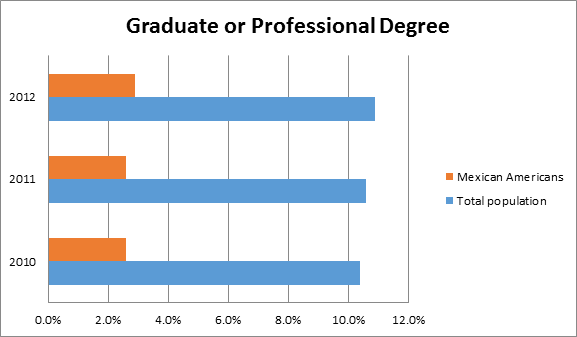
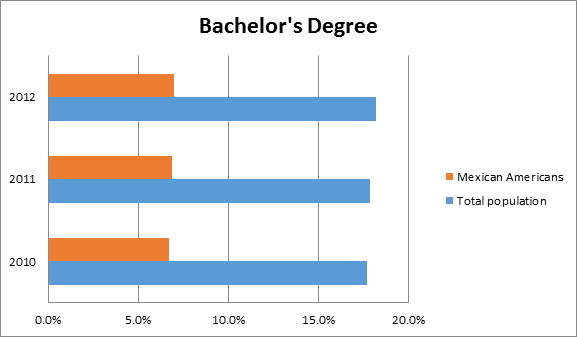
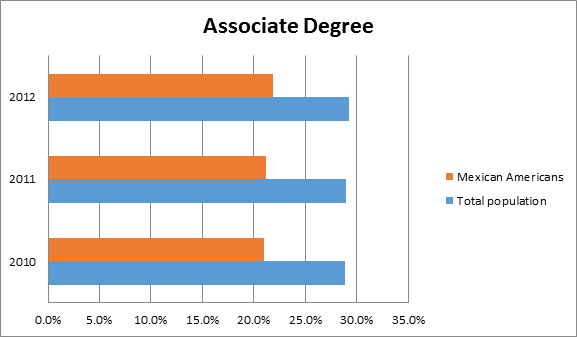
For occupations, there was a .2 percent increment yearly, but still shows that in management, business, science, and art occupations, there is still a wide gap between the total population at 36.1 percent for the year 2012 and 16.6 percent for Mexican Americans.


For professional, scientific, and management and administrative and waste management services, there is a close correlation between the percentage represented by the total population and Mexican Americans.

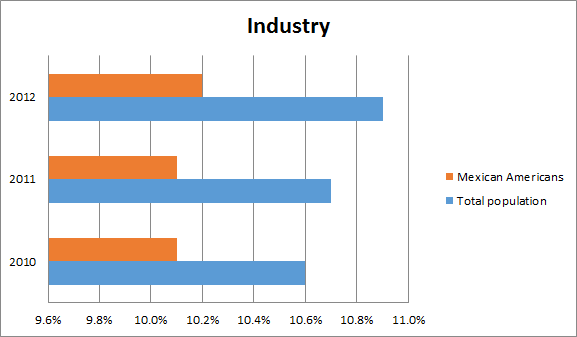
Summary:
There is hope at the end of the tunnel. College and university enrollment has been trending higher for Mexican Americans. Unfortunately, the percentage of students with graduate degrees stayed the same for the years 2010 and 2011, but rose a small amount in 2012. Percentages showing students with BA and AA degrees trended higher—an encouraging sign. Occupations still showed a wide margin between the total population and Mexican Americans. The Mexican American population showed a small increase in professional, scientific, and management and administrative and waste management employment while the total population showed a small but steady increase in this area.
References:
- Census Bureau, Selected Population Profile in the United States: 2010 – 2012
- United States S0201. Selected population Profile in the United States
- Population Group: Mexican and Total Population
- Data Set: American Community Survey 1-Year Estimates
Employment & Job News 2014: US Employers Hire 321,000 Employees in November; Latino Unemployment Drops Slightly
Employment & Job News 2014: US Employers Hire 321,000 Employees in November; Latino Unemployment Drops Slightly
U.S. employers hired 321,000 people in November, the latest sign of steady growth and health job gains. The latest job figures mean 2014 is on track to be the strongest year for hiring since 1999, and 10 million jobs were lost during the financial crisis in 2008.
More jobs, 44,000, were added in September and October than had previously been estimated. The Department of Labor said the unemployment rate remained at a six-year low of 5.8 percent.
Economy analysts say job gains will accelerate improvement in the labor market as more industries participate in the recovery. The Labor Department measured a 69.7 percent rate increase in its Diffusion index which measures industry payrolls…
Link to article
What It’s Like to Be a Latino Entrepreneur in Silicon Valley
November 24, 2014 SAN JOSE, Caif.—Alex Murillo leans forward in his seat, sipping coffee from a shot glass and waving his hands as he talks. He points to the screen of his MacBook Pro, explaining the genius behind Audive, the mobile application he is developing that allows users to record cover songs and mix tracks with music enthusiasts around the world.
“This is the secret sauce,” says Murillo, hitting a key on his computer that fills the air with the sound of a man singing in Italian. “You can bring in vocals from a guy in Italy or you can bring in the flamenco guitar from Spain.”
Murillo has made this pitch about three times to potential investors in Silicon Valley since launching his start-up this summer. He came up with the idea and polished his pitch with the help of Manos Accelerator, a…
Link to article
The next Mexican Revolution?
The Mexican Revolution, which launched on Nov. 20, 1910, was the first major political and social revolution of the 20th century. It brought an end to Porfirio Díaz’s 34-year dictatorship and transformed Mexico through land reform, the implementation of presidential term limits and the nationalization of natural resources.
Today, on the 104th anniversary of the revolution, Mexico faces another defining moment…
Link to article
Hopeful Gains in Higher Education for Mexican Americans
By Humberto Gutierrez
Edited by Kristen House
The latest figures from the 2013 American Community Survey show progress in the wide gap between the total US professional population and Mexican Americans:
- 2012 college and/or graduate enrollment was 28.8% for the total population but only 18.2% for Mexican Americans.
- 2013 college and/or graduate enrollment was 28.3% for the total population, 18.1% for Mexican Americans, and 33.3% for foreign-born Mexican Americans.
College enrollment for the total population has decreased from the years 2012 to 2013 by 463,000 according the Census Bureau as stated in their Sept. 24, 2014 press release.
For Mexican Americans, there was also an enrollment decrease, but not as pronounced. Mexican American enrollment dropped by only .1% whereas for the total population, there was a .5% drop in college enrollment.

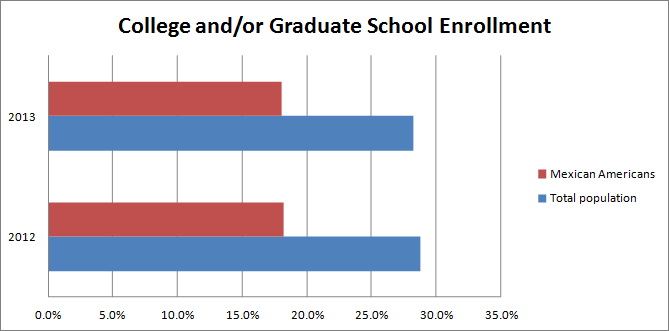
EDUCATIONAL ATTAINMENT
Educational attainment for the general population has risen by .3% from the years 2012 to 2013. For Mexican Americans, it has decreased by .1%
Earned bachelor’s degrees for the general population have risen by .2% and a bit more for Mexican Americans at .3%
Associate degrees and/or some college has shown little change across the board.
Unfortunately, only 2.8% of Mexican Americans and 1.5% of foreign-born Mexican Americans completed a graduate or professional degree in 2013. This is an extremely low percentage because the total population completion of a graduate or professional degree in 2013 was 11.2%. Why are Mexicans and native-born Mexicans not obtaining their graduate degrees? While only 7.3% of Mexican Americans have B.A. degrees, many are settling for associate degrees—21.8% of Mexican Americans and 12.1% of foreign-born Mexican Americans are ending their academic careers upon achieving these two-year degrees, according to the 2013 data.
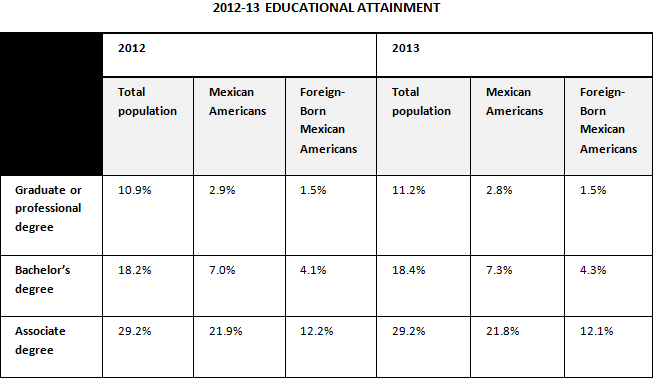

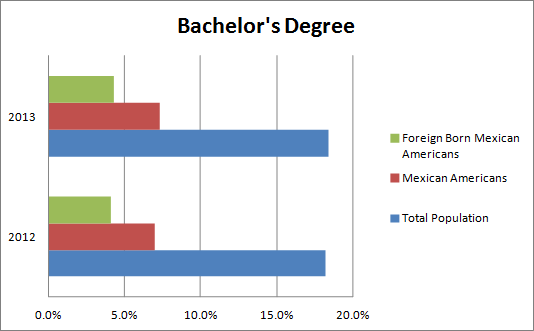
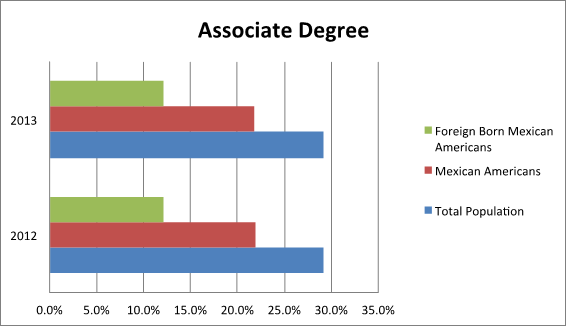
OCCUPATIONS
For the year 2013, the data for civilian employed population 16 years and over in management, business, science, and arts occupations is: 36.3% for the total population, 16.7% for Mexican Americans, and 9.2% for foreign-born Mexican Americans. Again, dismal figures.
Compared to the 2012 results, which were for the total population of 36.1% and for Mexican Americans 16.6%, there was a .2% increase for the total population and .1% for Mexican Americans. There was also a .2% increase for foreign-born Mexican Americans. Not much change, but some hope.
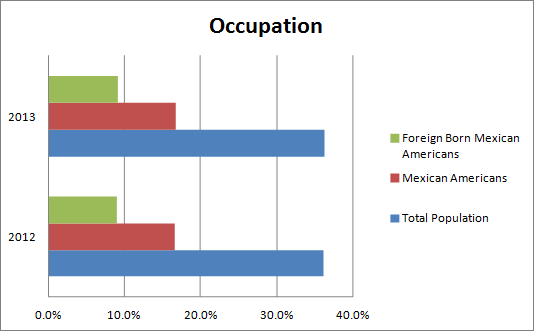
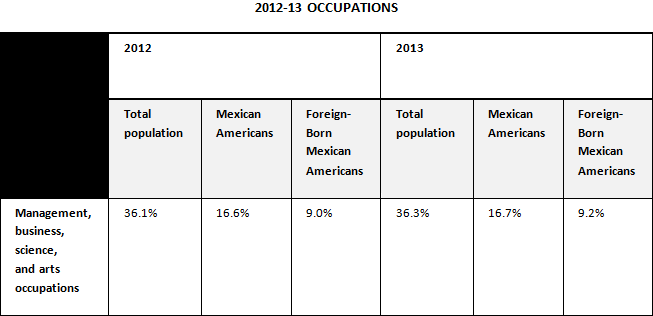
INDUSTRY
For professional, scientific, management and administration, and waste management services, 2013 employment for the total population was 11.1% and 10.2% for Mexican Americans, with foreign-born Mexican Americans at 11.5%. The 2012 results were for the total population 10.9% and 10.2% for Mexican Americans with the foreign-born Mexican Americans at 11.6%. No change for Mexican Americans and a .2% increase for the total population. However, a happy surprise: in 2013, foreign-born Mexican Americans topped all groups at 11.5% with a small decrease from 2012.
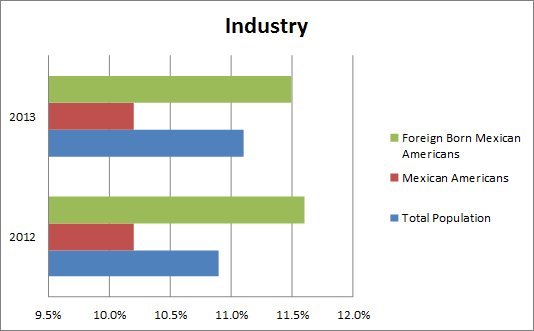
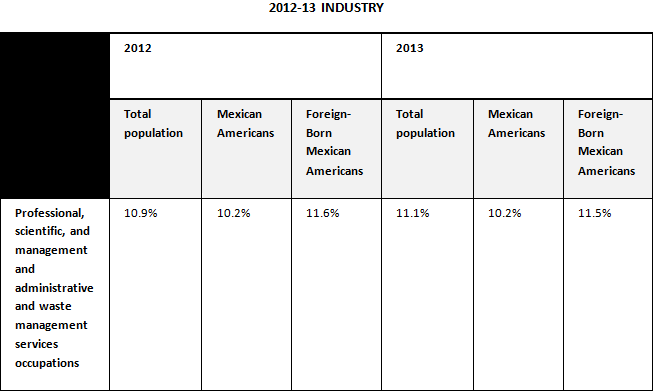
This represents a mixed picture for Mexican Americans and for foreign-born Mexican Americans in their quest for parity with the total population.
Solution for Retaining Minority Students in Higher Education
Scott Watson Swail’s 2003 report (1) on student retention programs in higher education states that a comprehensive student retention program should:
- rely on proven research
- suit the particular needs of the campus
- be institutionalized and become a regular part of campus service
- involve all campus departments and all campus personnel
- take into consideration the dynamics of the change process and provide extensive and appropriate retraining of staff
- be student centered
- operate in a cost-effective way, and not be tied to soft monies
- have the support of a comprehensive student monitoring system that will become the foundation of all institutional research on campus and support every department
- be sensitive to student needs and to diverse populations.
At least some of the above recommendations would go a long way to encourage many minority students to continue their higher education by obtaining a graduate or professional degree.
Berkley, Stanford, UCLA, and Caltech collaborate to boost minority Ph.D. students by recruiting underrepresented students in mathematical, physical and computer sciences, and in engineering.
UC Berkley put it best: “The four schools are creating a unique, cross-institutional community of underrepresented minority Ph.D. students, postdoctoral scholars, and faculty members in the targeted fields; developing faculty training to better recognize and help these students thrive and advance; and conducting research that includes annual surveys of Ph.D. students about what factors impact their attitudes, experiences and preparation for the future.”(2)
References
- Census Bureau, Selected Population Profile in the United States: 2012 and 2013
- United States S0201 and B 05006. Selected population Profile in the United States
- Population groups: Mexican and Mexico (foreign-born)
- Data set: American Community Survey 1-Year Estimates for years 2012 and 2013.
- Census Bureau, American Fact Finder, Selected population Profile in the Untied States.
————————————————–
(1) Watson Scott Swail, Retaining Minority Students in Higher Education: A Framework for Success, George Washington University, 2003
(2) Gretchen Kell, “Berkeley, Stanford, UCLA, Caltech unite to boost number of minority Ph.D. students, faculty,” UC Berkley News Center, February 13, 2014
Extraordinary Women in Texas: A Phenomenological Study of Mexican American Female Superintendents
SA Rodriguez – 2014
… from family and professional colleagues. These support mechanisms assisted them in coping
with cultural incongruence and school board affairs. The strategies and skills that the participants
depicted in this study will provide aspiring Mexican American female superintendents …
Link to dissertation
Majority of of STEM College Graduates Do Not Work in STEM
Jul 10, 2014 – About the Newsroom · Facts for Features · News Releases · Press Kits · Tip Sheets … The U.S. Census Bureau reported today that 74 percent of those who have … however these graduates are not necessarily employed in STEM occupations … The tables released today highlight statistics on field of degree, …
Link to press release
TJ conference explores Mexican diaspora
For years, whenever Enrique Hernandez was traveling abroad and people asked him where he’s from, he would give this answer: “We’re from Mexico City, but we’re living in San Diego.”
Lately, his response has become: “We’re from San Diego. Originally from Mexico City, but from San Diego.”
A Harvard-educated former government official in Mexico City, Hernandez is now partner in a law firm. He is also part of a diverse cohort of Mexicans who have decided to leave their home country for the United States. Some are doctors, lawyers, scholars, artists and entrepreneurs, while others are laborers and service workers…
Link to article
New Digital Archive Details Challenges for Mexican Journalists, Migrants
An innovative, open-access archive documenting personal stories of journalists who have been silenced, and also government processes that cannot be videotaped or photographed, is being introduced at the University of Arizona.
Called “The Documented Border,” the digital archive includes original border-related research material collected and curated by UA faculty along the U.S.-Mexico border, representing a unique resource for researchers, scholars and others interested…
Link to article
40 Under 40: Latinos in American Politics
A new generation of Latinos continues to move up in American politics. Some are immigrants, others are homegrown; most are progressive, but conservatives have elevated serious talent as well. Last year’s list of excellent Latinos in politics focused on Capitol Hill. This year’s looks further, to Latinos in key roles across the spectrum of American politics.
In 2014, the Obama administration…
Link to article
11 Hispanic Filmmakers Who Are Seriously Killing It
There was a time when even the most devoted American cinephile would struggle to name more than a few Latino directors beyond Pedro Almodovar and Luis Bunuel. Today, filmmakers like Alejandro Gonzalez Inarritu, Miguel Arteta, Alfonso Cuarón, Guillermo del Toro and Robert Rodriguez have become bankable names with movies that are embraced by broad audiences. But can “Gravity,” “Pacific Rim,” or “Sin City” be defined as Latino films?
There’s another group of Hispanic filmmakers who are really nailing their craft; they’re not yet household names in the U.S., but they’re reinvigorating genres, providing fresh perspectives, and reshaping the cinematic experience…
Link to article
The Elusive Bicultural Latino Audience
According to Horowitz Associates’ Focus: Latino 2014 report. Bicultural Latinos, Hispanics who feel strong cultural ties to both their U.S. and Hispanic identities, represent 53% of America’s Hispanics.
Biculturals, who tend to be more educated and make more money than average Hispanics, are a highly desirable target demographic for advertisers. Additionally, compared to total Hispanics and TV content viewers overall, biculturals are younger, more entertainment-oriented, and very tech-savvy. Many media companies and their advertisers are now working to develop effective strategies for engaging them…
Link to article
Latinos moving up to own, run farms
WATSONVILLE, Calif. — When he was 15, an immigration raid at a Japanese flower nursery turned Arturo Flores’ life around. The owners needed a new group of workers to replace the ones removed by immigration officials, and Flores landed a job cutting flowers.
He slowly worked his way up to packaging and delivering them. In the mid-1980s, he got a call from two businessmen looking to start their own cut-flower business. They asked him to manage deliveries and distribution. Today Flores, 50, is the president of Central California Flower Growers in Watsonville, a distributor in Santa Cruz County that sells more than 100 varieties of flowers and other plants…
Link to article
Robert Rodriguez: “The Future of Hispanic TV is in English Programming”
Robert Rodriguez is working his magic on English-speaking Latino audiences with his new network, El Rey.
During a recent interview with The Hollywood Reporter, the 46-year-old Sin City director revealed what made him decide to launch a TV network.
“John Fogelman and Cristina Patwa at FactoryMade told me, ‘There’s an opportunity for a TV network. Comcast is giving them away.’ So I came up with the concept for El Rey,” Rodriguez explained…
Link to article
Chuckawalla’s Chicano Correctional Workers Association (CCWA) presents scholarships
BLYTHE, Calif. – Chicano Correctional Worker’s Association (CCWA) and avid supporters Chuckawalla Valley State Prison (CVSP) Warden A. M. Gonzales and Chief Deputy Warden C. Callahan continue to impart the importance of education by presenting scholarships to Carly Renee Teater ($900) and Destiny Lopez ($600).
The recipients were selected by CCWA scholarship committee members and were presented certificates and checks by CCWA Chapter President Evelyn Garcia…
Link to article
Young Latino Mayor Pete Aguilar Could Turn a Red House Seat Blue
Long before he aspired to be in Congress, Democrat Pete Aguilar’s dream was to be like his father who worked for the local utility.
“My mother tells the story that she made me a little uniform just like his and I think she has baby books that she shows …He worked for the local gas company for 37 years,” Aguilar said.
But he didn’t fill his father’s shoes. Instead, at age 26 he set his own path and became the youngest city council member in the California city of Redlands’ 126-year history when five council members, Democrat and Republican, picked him out of 11 candidates to fill an open seat. He was elected to the seat a year later, his first election. Then his colleagues appointed him mayor in 2010 and again in 2012.
Today Aguilar’s going after another vacancy, the U.S. House seat for California’s 31st Congressional District. The incumbent, Republican Rep. Gary Miller was in for a bruising race as the Democrats’ No. 1 target. He chose to retire. Aguilar, a Democrat, and his opponent Republican Paul Chabot will face off in November…
Link to article
The United States and Mexico: Forging a Special Relationship
Should the United States and Mexico establish a “special relationship,” similar to those the US maintains with Great Britain and Israel? For Samir Tata, an increasingly self-confident and politically active Mexican – American population means that the historical, geographical, demographic and economic case has never been more compelling…
Link to article
The Population With a Bachelor’s Degree or Higher by Race and Hispanic Origin: 2006–2010
This report examines people aged 25 and over with a bachelor’s degree or higher among racial and Hispanic-
origin groups. As the U.S. population becomes more racially and ethnically diverse, it is important to exam-
ine educational attainment among population groups,which is a strong predictor of economic well-being.
Also, government agencies require data on educational attainment for funding allocations and program plan-
ning and implementation, while local government use information on educational attainment to attract
potential employers to their areas…
Link to report


